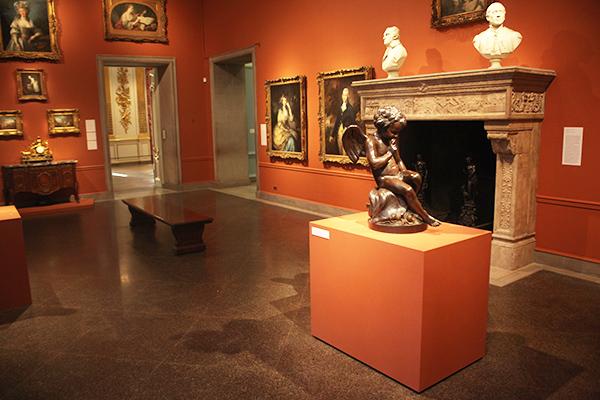A D.C. judge has signed off on GW’s landmark merger with the Corcoran College of Art + Design, ending a month-long legal battle.
The decision allows GW to absorb the arts school and the Corcoran to send 17,000 artworks to the National Gallery of Art. A six-day orientation for Corcoran students begins this week, but administrators will still have to quell fears from a student body that has long worried about losing the creative atmosphere of its small design school.
About 190 undergraduates and 180 graduate students from the Corcoran are enrolled at GW for the fall semester, said University spokeswoman Maralee Csellar. Thirteen students graduated with a fine arts degree from GW last year.
The hearings that led up to the court’s decision combed through GW’s plans to absorb the Corcoran, which the arts institution’s accreditors said was likely the only way to save the financially failing school from closure. Accrediting officials argued that the University’s plan offered “the greatest amount of financial support,” according to court documents.
The hearings, which included testimony from University President Steven Knapp, revealed decades of efforts to resurrect the financially crumbling institution and the court’s hesitancy to hand its school over to GW.
“This Court finds it painful to issue an order that effectively dissolves the Corcoran as an independent entity,” Judge Robert Okun ruled. “But this Court would find it even more painful to deny the relief requested and allow the Corcoran to face its likely demise.”
After it ran a deficit for “the majority” of the past 13 years, the Corcoran’s board of trustees approved tuition increases, consolidated departments, reduced travel expenses and mandated oversight on spending that topped $2,500, according to court documents.
Turnover in the Corcoran’s fundraising office and on its board added more pressure, and recent senior staff hires lacked experience in running museums or colleges.
[RLBox]
[RL articlelink=”https://www.gwhatchet.com/2014/02/20/with-questions-hanging-over-corcoran-merger-gw-focuses-on-opportunities-for-arts/”]
[RL articlelink=”https://www.gwhatchet.com/2014/02/23/at-rescued-corcoran-college-a-new-kind-of-uncertainty/”]
[RL articlelink=”https://www.gwhatchet.com/2014/06/12/columbian-college-of-arts-and-sciences-to-absorb-corcoran-school/”]
[/RLBox]
Corcoran trustees will keep their positions once the merger is complete, Corcoran spokeswoman Mimi Carter said. She declined to say whether a Corcoran trustee would sit on GW’s Board of Trustees.
In court, opponents of the merger argued that the board has “overstated the severity of the Corcoran’s current financial condition and understated its ability to raise the funds needed to address its financial conditions.” They offered alternative solutions, such as selling some of the Corcoran’s art or revving up fundraising efforts.
Terrence Shanahan, an attorney and member of the advocacy group Save the Corcoran, was among the strongest opponents. He said anyone holding on to “cautious optimism” about the success of the Corcoran’s programs under GW will “not be rewarded.”
“I think kids that are really serious about art will discover that it’s a lot different going to a factory to learn art work than it is to go to an atelier, and that’s what is going to happen,” Shanahan said.
The Corcoran also deferred renovations to its 115-year-old building on 17th Street to cut spending. The building now has an “extremely poor” sprinkler system, leaving it at risk for fire, according to court documents. With the court’s approval, GW will begin renovations that could cost a total of $80 million. Galleries will close on Oct. 1, making room for more classrooms and studio space.
Save the Corcoran helped block the sale of the 17th Street building two years ago, and Shanahan said the group will now act as a “constant reminder of what could have been.”
“Some people who have some interest in the institution probably won’t realize for quite a while the true magnitude of what’s happened,” he said. “The Corcoran will never cease to exist, but it will be one grain of sand in a vial instead of a beach.”
Miguel Perez, the undergraduate vice president of the Corcoran’s Student Council, said it will be a “tough year” for Corcoran students even though the merger was finalized before the first day of classes.
“Our concerns are more long term – what the future of the institution under GW will be, concerns about programs that don’t draw enough attention to continue to thrive and concerns about what our faculty will look like next year when their contracts are up,” Perez said.
GW has given full-time Corcoran professors one-year contracts, while about 150 faculty and staff will lose their jobs this fall.
Corcoran faculty had a full day of orientation Wednesday, discussing topics like conducting research, campus security, student support and “surviving and enjoying” the first year at GW. The orientation was capped with a dinner hosted by Provost Steven Lerman and his wife, according to documents obtained by The Hatchet.
Joey Mánlapaz, a GW alumna and former Corcoran associate professor, was not offered a spot to teach at GW this fall. But she has submitted her resumé and said the court’s ruling is still a “good thing.”
“The train has left the station many, many months ago. It’s a very important step, so now it’s finalized,” she said.
Still, Mánlapaz said “many” of her students have decided to attend other colleges, partly because Corcoran students may eventually have to pay GW’s full tuition, a $17,000 increase from what they pay now.
“Right now everybody is sort of nervous about their positions. It’s nerve wracking,” Mánlapaz said.








